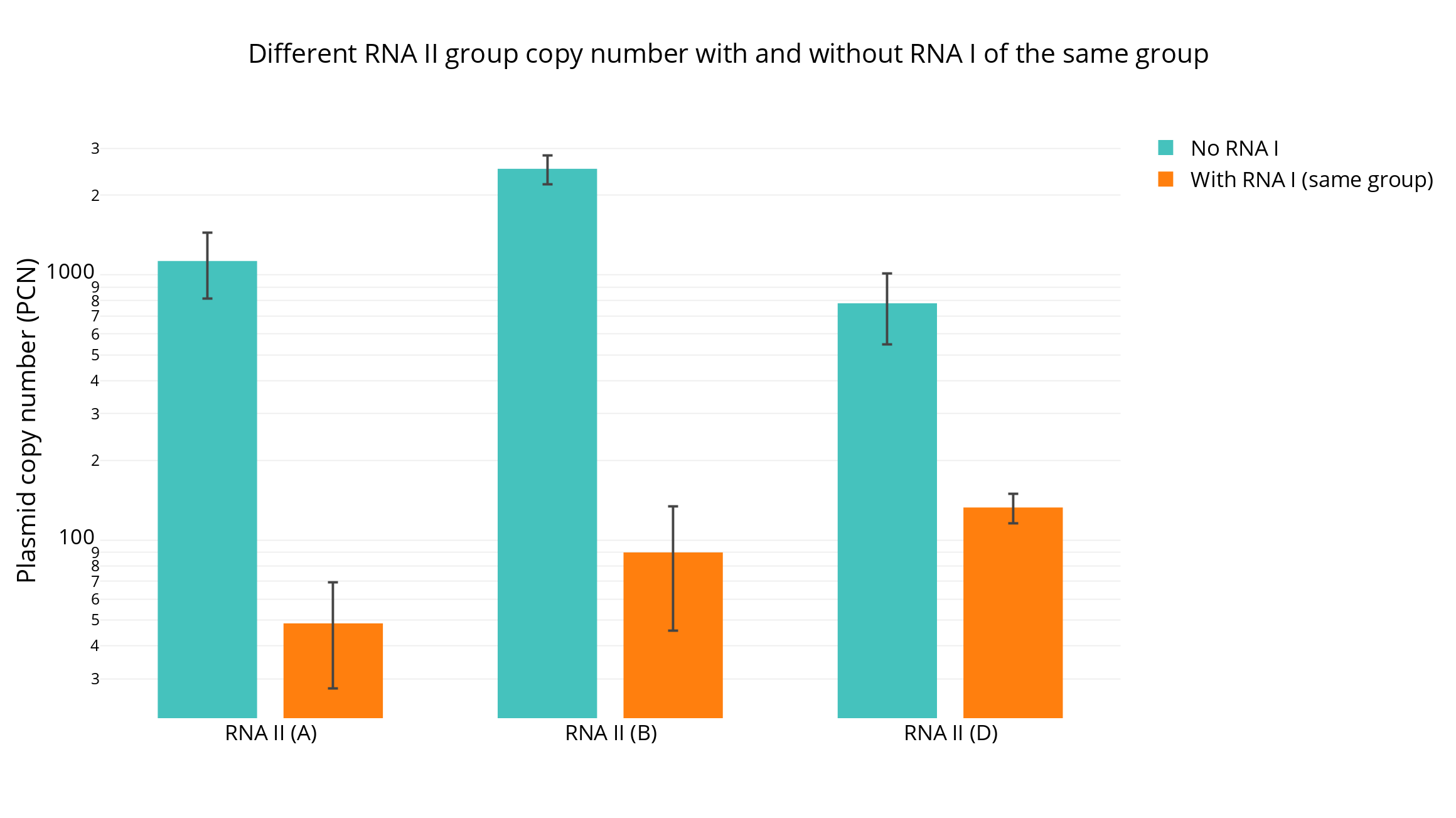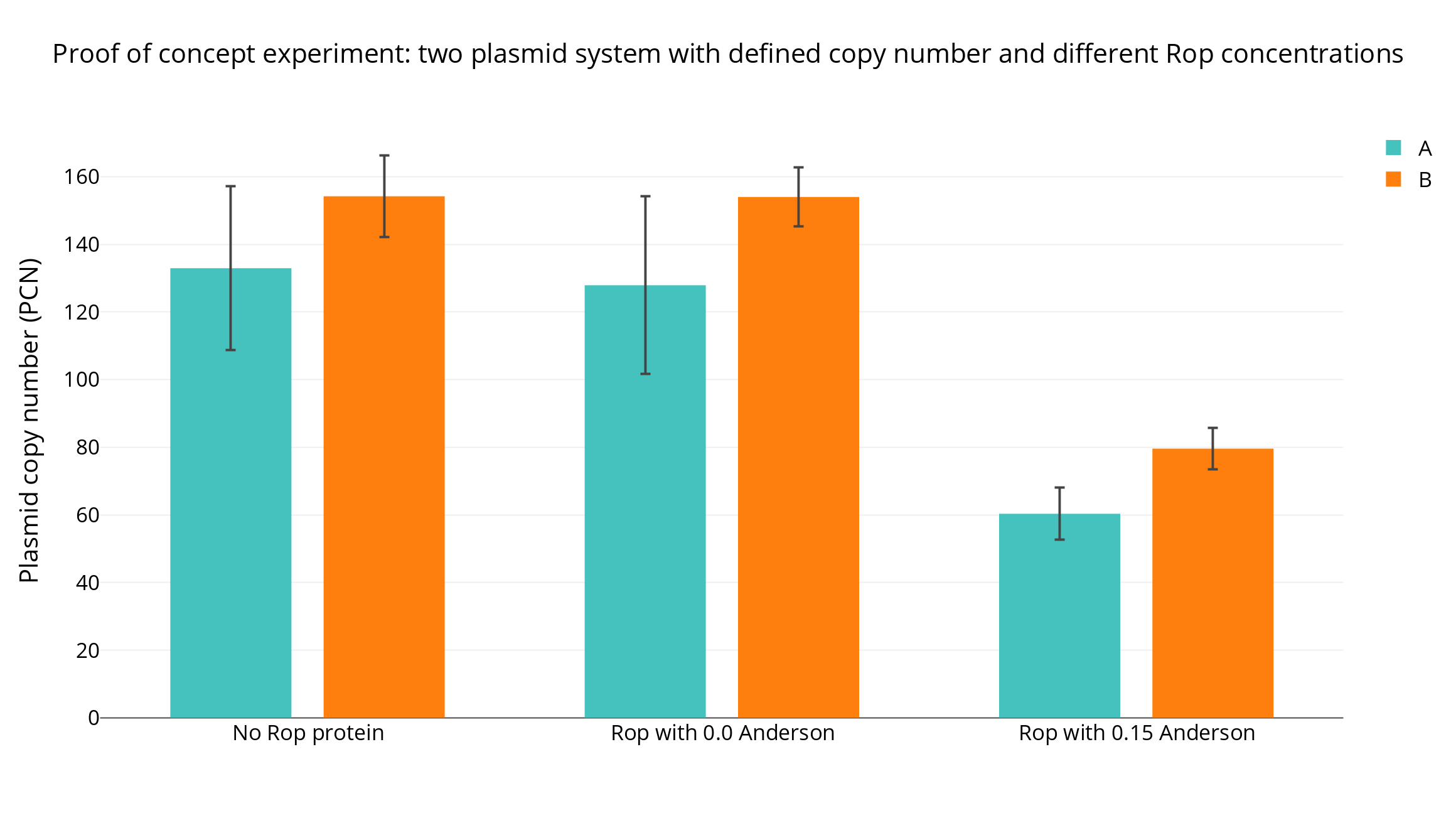Part:BBa_K2259073
Rop protein with anderson (0.15) promoter for global plasmid copy number control
When placed in a SynORI system this device lowers plasmid copy number of each group as it can bypass the selective control. It consists of a weak Anderson promoter, weak Anderson RBS, ROP protein and a double terminator.
Device also works with other plasmids consisting of ColE1 origin of replication
Devices from the same series that have different Anderson promoters: part:BBa_K2259072 (0 Anderson), part:BBa_K2259073 (0.15 Anderson), part:K2259074 (0.24 Anderson).
See how this part fits into the whole SynORI framework by pressing here!
Sequence and Features
- 10COMPATIBLE WITH RFC[10]
- 12INCOMPATIBLE WITH RFC[12]Illegal NheI site found at 7
Illegal NheI site found at 30 - 21COMPATIBLE WITH RFC[21]
- 23COMPATIBLE WITH RFC[23]
- 25COMPATIBLE WITH RFC[25]
- 1000COMPATIBLE WITH RFC[1000]
Contents
Introduction
Biology
Repressor of primer (ROP) is a small dimeric protein that participates in ColE1 plasmid family copy number control, by increasing affinity between two complementary RNAs - RNA I (Replication inhibitor) and RNA II (Replication activator) (Fig. 1). [1] By increasing affinity of the two RNA molecules, Rop decreases the rate of plasmid replication initiation events.

Rop dimer is a bundle of four tightly packed alpha helices that are held by hydrophobic interactions (Fig. 2).
Usage with SynORI (Framework for multi-plasmid systems)
About SynORI
SynORI is a framework for multi-plasmid systems created by Vilnius-Lithuania 2017 which enables quick and easy workflow with multiple plasmids, while also allowing to freely pick and modulate copy number for every unique plasmid group! Read more about [http://2017.igem.org/Team:Vilnius-Lithuania SynORI here]!
This device in SynORI
This is a constitutive global copy number modulator device which lowers plasmid copy number of every group in the system bypassing the selective control of different groups. These constitutive devices can be used with different Anderson promoters to select a different copy number.
Devices from the same series that have different Anderson promoters: part:BBa_K2259072 (0 Anderson), part:BBa_K2259073 (0.15 Anderson), part:K2259074 (0.24 Anderson).
See the [http://2017.igem.org/Team:Vilnius-Lithuania Vilnius-Lithuania 2017 team wiki] for more insight about our synthetic origin of replication (SynORI).
Further details
For more background information and indepth insight on this part's design please see the individual part page of ROP proteinpart:BBa_K2259010.
Characterization of Rop protein (Vilnius-Lithuania 2017)=
Rop expression
We have first decided to verify the expression of Rop protein to make sure that our designed Rop gene gives appropriate mRNA which is translated in the cell correctly. Rop gene was then placed under inducible T7 promoter. After two hours of growth, E. coli DH5α cells containing plasmid with Rop gene were induced using 1 mM IPTG. Soluble proteins from the cell lysates were separated by centrifugation and then used for SDS-PAGE. Size of Rop protein is 7,5 kDa, so it can be seen below 10 kDa size standard mark. Figure 3 shows, that Rop protein was induced successfully and its quantity increases by prolonging cell growth. It is found in soluble protein fraction which strongly suggests that Rop protein possibly forms an active spatial structure in vivo and might influence RNA I-RNA II duplex formation.
Constitutive Rop protein effect on plasmid copy number
We have then wanted to see if we can add a constitutive Anderson promoter to Rop gene in order to change the copy numbers of a plasmid group. We have cloned 3 different Anderson promoters next to Rop gene and then moved it next to RNA I. We then moved these 3 intermediate parts (part:BBa_K2259072, part:BBa_K2259073, part:BBa_K2259074) into the minimal SynORI vector (part:BBa_K2259092) next to RNA II (part:BBa_K2259075, part:BBa_K2259053, part:BBa_K2259052). We have then calculated the plasmid copy number.
As seen in in the Figure 4, our Rop protein constructs successfully lower the plasmid copy number. Each Anderson promoter increases Rop concentration and consequently, lowers plasmid copy number.
Inducible Rop protein effect on plasmid copy number
We have also investigated Rop protein with inducible Rhamnose promoter in order to have a viable option of inducible copy number control. We have cloned Rop gene next to Rhamnose promoter and RNA I (BBa_K2259070) and then placed this construct next to RNA II (part:BBa_K2259076) in SynORI minimal vector (part:BBa_K2259092).
These results show that Rhamnose promoter is too strong for Rop protein expression, because even the leakage of promoter at 0 percent induction leads to copy decrease to average 1 copy per cell. That means that cells can barely survive and if they do, the inhibition level is so high they cannot maintain more than one plasmid.
Despite the high expression level this device can still prove to be useful in the future, for example if characterized with an active partitioning system this construct could become a useful tool for extremely low copy plasmid group generator.
Rop protein as a global regulator
When different groups of SynORI system were created the abilty of corresponding RNA I to inhibit the replication of RNA II were measured by calculating the plasmid copy number with and without RNA I in the system
As can be seen in Figure 6, RNA I introduction into the system has a significant effect on the plasmid copy number of the specific group, thus we can conclude that RNA I works on corresponding RNA II.
To prove that RNA I works only on the specific RNA II, different groups of SynORI devices were placed in a cell by co-transformation and plasmid copy numbers were calculated. SynORI global copy number control devices (part:BBa_K2259072 (0 Anderson), part:BBa_K2259073 (0.15 Anderson), part:K2259074 (0.24 Anderson)) were co-transformed together with B-GC SynORI device (BBa_K2259078) and (part:BBa_K2259072 (0 Anderson), part:BBa_K2259073 (0.15 Anderson), part:K2259074 (0.24 Anderson)) with D-GC SynORI device (BBa_K2259079).
As can be seen in Figure 7 and Figure 8 RNA II A, RNA II B and RNA II D act as different ORIs and their corresponding RNA I inhibits the replication of SynORI groups specifically.
It can also be concluded that Rop protein placed in a single plasmid lowered the plasmid copy number of both plasmid groups, this proves that Rop works by binding to a kissing-loop complex and is able to bypass the individual control of different groups.
References
- ↑ Castagnoli L, Scarpa M, Kokkinidis M, Banner DW, Tsernoglou D, Cesareni G. Genetic and structural analysis of the ColE1 Rop (Rom) protein. The EMBO Journal. 1989;8(2):621-629.
- ↑ Banner DW, Kokkinidis M, Tsernoglou D. Structure of the ColE1 Rop protein at 1.7 Å resolution. J Mol Biol. 1987 m.;196(3):657–75.
//collections/synori
| None |








